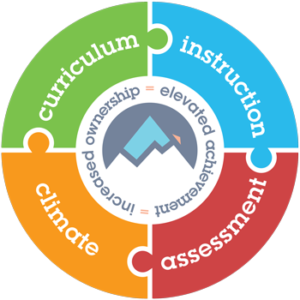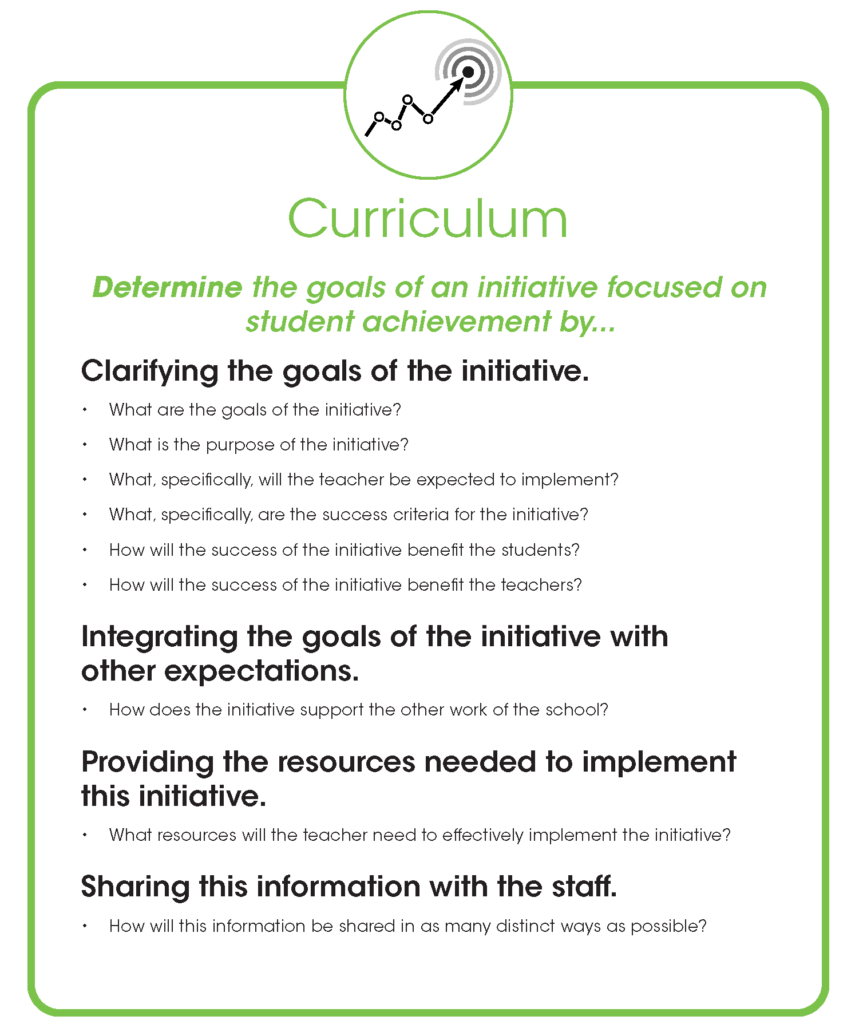Share this article.
An article for school administrators and aspiring administrators
Dear educator, we believe that of all the skills a principal needs to succeed, the most vital, in terms of increasing academic achievement, is that of instructional leadership. And the skill of instructional leadership is made up of actions that can be seen and heard. We also believe that the actions of instructional leadership can be developed.
 You believe this, too, otherwise you would not have clicked on this article.
You believe this, too, otherwise you would not have clicked on this article.
We, at Elevated Achievement, want to support you in building your dream school. That’s why this article is part of a series of articles that show current principals, assistant principals, and future administrators how to turn your dream into your reality by developing the actions of instructional leadership in curriculum, instruction, assessment, and climate.
This article focuses squarely on the first action—the action of instructional leadership in curriculum: Determine an initiative whose successful implementation will elevate student achievement.
Developing Instructional Leadership
First, we want to be clear. When we talk about instructional leadership, we are talking about the art of inspiring a group of people toward achieving a common set of goals for learning and academic achievement. And the group of people that have the most significant effect on student achievement are the classroom teachers. Time and again, research bears out that effective teachers are the most important factor contributing to student achievement. As RAND Education (2021) reminded us,
“…research suggests that among school-related factors, teachers matter most. When it comes to student performance on reading and math tests, a teacher is estimated to have two to three times the impact of any other school factor, including services, facilities, and even leadership (p. 1).”
In other words, because your teachers are key to the implementation of any initiative focused on elevating student achievement, you must get them to own their role in the implementation of this initiative and the learning it requires. And, you can achieve this by being a principal who develops the skill of instructional leadership.
Let’s start by focusing on the first action—the action of instructional leadership in curriculum.
The First Action of Instructional Leadership
The first action is to determine an initiative whose successful implementation will elevate student achievement. This is a larger goal than one of your basic administrative concerns. For example, this initiative could be driven by the district—the development and implementation of a course scope and sequence. This initiative could be site-based—the development and implementation of a data-analysis protocol whose purpose is to discover why students are achieving as they are. This initiative could be for one department—the use of a new textbook, materials, or resources. Or this initiative could be more specific to individual teachers’ needs—instructional strategies that support the reading of more complex text. As a principal, you can think of this as the curriculum of the initiative.
In order to lead the successful implementation of an initiative, the principal needs to understand and share the answers to the following questions:
- What is the initiative?
- What is the purpose of the initiative?
- What are the success criteria of the initiative?
- How will this information be shared with the teachers?
This means that the principal must clarify the goals of the initiative, integrate the goals of the initiative with other expectations, provide the resources needed to implement this initiative, and, most importantly, share this information with the staff.
This tool is provided as a resource for you to use when determining the goals of your initiative.
An Example of Instructional Leadership in Curriculum
When speaking with Principal Thompson, he explained that he knew his task was to determine and lead these actions:
- Clarify the goals of the initiative.
- Integrate the goals of the initiative with other expectations.
- Provide the resources needed to implement the initiative.
- Share this information with the staff.
He began the process by answering the question from the planning tool above.
What are the goals of the initiative?
PRINCIPAL THOMPSON:
“I was with the English teachers reviewing data from this past year. There were some skills that the students overall did not perform well on. We began to discuss where these skills fell within the standards. It became clear to me immediately that my teachers were not all viewing the skills within in the standards in the same way. There seemed to be disagreements as to what the standards expected students to be able to do, which standards were taught this year, if the standards were the instructional focus or if the text being read was the focus. The team was not on the same page at all.”
“After that day, I met with the lead English teachers of each grade level and discussed my concerns. We came to an agreement that the first thing we needed to do to focus on learning loss recovery for literacy was to develop and implement a standards-based scope and sequence.”
Once that goal had been determined, Principal Thompson then had to determine the following:
What is the purpose of the initiative?
PRINCIPAL THOMPSON:
“Our overall purpose is to close the gaps from this past year. To do that, we have to ensure we have a standards-driven curriculum. This means our teachers must know what skills the students should master by the end of the year, the sequence in which they will be taught, and how these decisions were made.”
What, specifically, will the teacher be expected to implement?
What, specifically, are the success criteria for the initiative?
PRINCIPAL THOMPSON:
“I knew I then had to decide what it was I expected from the teachers. I knew it was not enough for us to build a standards-driven scope and sequence that teachers would just follow. I knew that would lead to passive compliance. What was most important to me was that the teachers owned the scope and sequence. They needed to have a deep understanding of the standards, they needed to be able to justify the decisions made around the scope and sequence, and they needed to be able to articulate, every week, which skills they are directly teaching or supporting in each lesson, and where their students are in mastering those skills. Our success will be measured by their decisions and their ability to articulate and justify them.”
But Principal Thompson knew that if he wanted real buy-in from his teachers, they would have to see the benefits to this work. He then had to determine:
How will the success of the initiative benefit the students?
How will the success of the initiative benefit the teachers?
PRINCIPAL THOMPSON:
“I knew that if they were all stronger in the standards and we had a carefully planned scope and sequence, there would be ongoing benefits beyond recovering the learning loss from this past year. Our teachers would be equipped with the knowledge to focus on the skills of the standards in a manner that allowed for meaningful integration. It would benefit our students to have authentic opportunities to learn, practice, and apply the skills throughout the coming year.”
“But I know I have a range of teachers. Some are open and always looking for ways to grow. But I do have some that are quite set in their ways. If I was going to get the teachers to meet these expectations, they all had to see what was in it for them. I also knew that I couldn’t lead this initiative on my own. I made certain I worked with the lead teachers to carefully craft our messaging.”
“When we explained what we were planning to do this coming year, we made sure we did it in a way that honored our teachers. We asked teachers to identify the standards they felt the most confident about and to bring to our sessions examples of how they have been successful with them. Thus, when we conduct the training, we will have them share. The teachers should leave with a much deeper understanding of the standards and were participants in the session.”
“As we develop the scope and sequence, we will have the teachers develop the justification statements for the decisions they make. I know that if my teachers can articulate how and why the decisions were made, they will own them. More importantly, they will own the thinking behind them.”
“For our students, we are now confident that regardless of the class they are assigned, they will be provided with a standards-driven curriculum. Our teachers will be able to have stronger grade-level conversations and share ideas and successes. And our teachers will be able to have vertical conversations so we can more closely monitor student progress from year to year.”
To ensure that his teachers did not feel overwhelmed, Principal Thompson had to determine:
How does the initiative support the other work of the school?
PRINCIPAL THOMPSON:
“During the pandemic we still followed our data protocol process. I can see clearly how our work on our standards-based scope and sequence aligns beautifully to that work. But it isn’t enough that I see it. I need my teachers to make the connections. Rather than me telling them what I thought, I asked them. At our year-end meeting, I brought out our work from this year—its goal, purpose, benefits, etc. I asked the teachers to decide if the development of a scope and sequence will support our previous work. If so, how? If not, why?”
“The teachers overwhelmingly saw the connections and benefits. They identified that having a scope and sequence would strengthen their data analysis. It would ensure that our focus was not on the lessons they taught but on the learning of the skills of the standards. They saw how they could expand their data conversations from just their grade level to across the grade levels. This only increased their buy-in!”
To ensure that his teachers had sufficient resources and materials to successfully implement the initiative, Principal Thompson had to determine:
What resources will the teacher need to effectively implement the initiative?
PRINCIPAL THOMPSON:
“If we are going to ask our teachers to learn something new, and possibly change the way they have been working, we have to make certain they have the right resources that will help them. We need resources on standards, sample scope and sequences, and exemplar integrated units. We decided to utilize an outside professional development company that will help us see the standards in a new light and that could guide us through the process of developing a scope and sequence.”
“We also want to make certain we provided them with time and support. We already have weekly grade-level PLC meetings set in our schedule. In addition, we will offer dedicated time for collegial lesson study opportunities and optional additional standards training for those who feel they will benefit from it.”
To ensure that his message was clearly articulated and understood, Principal Thompson had to determine:
How will this information be shared in as many distinct ways as possible?
PRINCIPAL THOMPSON:
“I have been working hard on being more effective with communication over the last couple of years. I learned the hard way that what I say is not always what people hear. I knew that I needed to be super redundant in my communication on every level of this initiative. This meant that things needed to be repeated over and over. And not just in one manner but in lots of ways. I also make certain I put our message in writing. This allows people to read it in their voice, and it gives them time to reflect on the message and the space to generate questions they may have.”
“In addition, I make sure to work with the leadership team. First, we all have to be on the same page about how to discuss the initiative. We decide what to say and how we will share in the delivery of the message. This way, it is stated by many and heard by many.”
“By the time we begin this work in July, the teachers will have heard our plan in a variety of way and from a variety of folks.”
So, What’s Next for Principal Thompson?
PRINCIPAL THOMPSON:
“We will have our first session at the end of July. A team has committed to come for five days and develop a draft scope and sequence we will implement and revise as they year progresses.”
So, What’s Next for You?
 What is the practical answer to the question, “What are the actions of a principal who effectively leads a school with the outcome of elevating academic achievement for each and every student?” In other words, “What are the actions of instructional leadership?”
What is the practical answer to the question, “What are the actions of a principal who effectively leads a school with the outcome of elevating academic achievement for each and every student?” In other words, “What are the actions of instructional leadership?”
There are four.
This article has focused on the action of instructional leadership in curriculum: Determine an initiative whose successful implementation will elevate student achievement. We have shown you how to utilize this action. We have offered you a tool to support implementation. We have provided a detailed example of what it looks like when a principal utilizing this action.
Want to know more about the actions of instructional leadership in instruction, assessment, and climate? Check out our other articles in this series:
- “How to Determine Support for an Initiative that Elevates Student Achievement” — the action of instructional leadership in instruction
- “How to Determine the Monitoring System for an Initiative that Elevates Student Achievement” — the action of instructional leadership in assessment
- “How to Build a Community of Leaders that Elevates Student Achievement” — the action of instructional leadership in climate
Continue the Learning
Check out these articles and resources to continue your learning about this topic…
The Learning Brief
In this article you learned…
- The first action of instructional leadership.
- How to determine an initiative whose successful implementation will elevate student achievement.
- How to implement the first action of instructional leadership with a tool and an example.
Can you imagine building an environment full of motivated, engaged, and eager students who own their learning?
We can.


